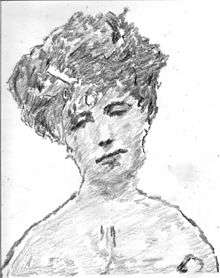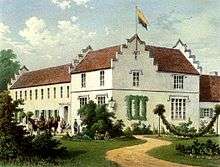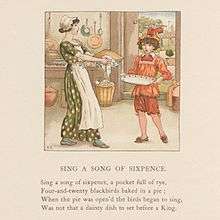Elizabeth von Arnim
Elizabeth von Arnim (31 August 1866 – 9 February 1941), born Mary Annette Beauchamp, was an Australian-born British novelist. She married a German aristocrat and her best-known works are set in Germany. After her first husband's death, she had a three-year affair with the writer H.G. Wells, then later married Frank Russell, elder brother of the Nobel prize-winning writer and philosopher Bertrand Russell. She was a cousin of the New Zealand-born writer Katherine Mansfield. Her first marriage made her Countess von Arnim-Schlagenthin and her second Elizabeth Russell, Countess Russell. Though known in early life as Mary, publication of her first book introduced her to readers as Elizabeth, which she eventually became to her friends and finally even to her family. She is now known invariably as Elizabeth von Arnim.[1] She used the pen name Alice Cholmondeley only for the novel Christine, published in 1917.[2]
Elizabeth Russell Countess Russell | |
|---|---|
 Pencil sketch of Elizabeth von Arnim | |
| Born | Mary Annette Beauchamp 31 August 1866 Kirribilli Point, Australia |
| Died | 9 February 1941 (aged 74) Charleston, South Carolina, United States |
| Resting place | Tylers Green, Bucks, England |
| Pen name | Elizabeth |
| Occupation | Writer |
| Nationality | British |
| Period | 1898–1936 |
| Spouse | Henning August von Arnim-Schlagenthin
( m. 1891; died 1910)John Russell, 2nd Earl Russell
( m. 1916; died 1931) |
| Children | 5 |
| Relatives | Katherine Mansfield (cousin) |
Biography

She was born at her family's holiday home in Kirribilli Point in Sydney, Australia. Her parents were Henry Herron Beauchamp (1825–1907), a wealthy shipping merchant, and Elizabeth (Louey) Weiss Lassetter (1836–1919). She was called 'May' by her family and she had four brothers and a sister.[3] One of her cousins was the New Zealand-born Kathleen Beauchamp, who wrote under the pen name Katherine Mansfield. When she was three years old, the family moved to England, where they lived in London, but also spent several years in Switzerland.[1][4]
Von Arnim was a first cousin of Mansfield's father, Harold Beauchamp, making the two women first cousins, once removed. Although Elizabeth was older by 22 years, she and Mansfield later corresponded, reviewed each others works and became close.[5] Mansfield, ill with tuberculosis, lived in the Montana region of Switzerland (now Crans-Montana) from May 1921 until January 1922, renting the Chalet des Sapins with her husband John Middleton Murry from June 1921. The house was only a "1/2 an hour's scramble away" from von Arnim's Chalet Soleil at Randogne. Von Arnim visited her cousin often during this period.[5] They got on well, although Mansfield considered the much wealthier von Arnim to be patronising.[6] Mansfield satirised von Arnim as the character Rosemary in a short story, "A Cup of Tea", which she wrote while in Switzerland.[5][7]
She studied at the Royal College of Music, principally learning the organ.[8]
On 21 February 1891, Elizabeth married the widowed German aristocrat Count Henning August von Arnim-Schlagenthin (1851–1910) in London,[9] whom she had met on a tour of Italy with her father two years earlier.[2] They lived in Berlin initially and in 1896 moved to what was then Nassenheide, Pomerania (now Rzędziny in Poland), where the von Arnims had their family estate.[10]
The couple had four daughters and a son. Their tutors at Nassenheide included E. M. Forster, who worked there for several months in the spring and summer of 1905.[11] Forster wrote a short memoir of the months he spent there.[12] From April to July 1907 the writer Hugh Walpole was their tutor.[13]
In 1907, Count von Arnim was imprisoned for fraud, and in 1908 Elizabeth moved to London with the children.[2] The couple did not consider this a formal separation, although the marriage had been unhappy due to the Count's affairs and they had slept in separate bedrooms for some time. In 1910, financial problems meant the Nassenheide estate had to be sold. Later that year Count von Arnim died in Bad Kissingen, with his wife and three of their daughters by his side.[3][14] In 1911, Elizabeth moved to Randogne, Switzerland, where she built the Chalet Soleil and entertained literary and society friends.[15] From 1910 until 1913, she was a mistress of the novelist H.G. Wells.[4]
The von Arnim's daughter Felicitas, who had been at boarding school in Switzerland and later in Germany, died of pneumonia aged 16 in 1916, in Bremen. She had been unable to return to England due to restrictions caused by World War I travel and financial controls.[16]
Von Armin married Frank Russell, the second Earl Russell and elder brother of Bertrand Russell, in 1916. The marriage ended in acrimony, with the couple separating in 1919, although they never divorced. She then went to the United States , where her daughters Liebet and Evi were living. In 1920 she returned to her home in Switzerland, using it as a base for frequent trips to other parts of Europe.[2] In the same year she embarked on an affair with Alexander Stuart Frere (1892–1984), who later became chairman of the publisher Heinemann. He was 26 years her junior. He initially went to stay at the Chalet Soleil to catalogue her large library, and romance ensued. The affair lasted several years. In 1927 he married Patricia Wallace Frere, and named his only daughter Elizabeth (later Elizabeth Frere Jones) in von Arnim's honour.[14]
In 1930, she set up home in Mougins in the south of France, seeking a warmer climate. She created a rose garden there and called the house Mas des Roses. She continued to entertain her social and literary circle there, as she had done in Switzerland. She retained this house to the end of her life, although she moved to the United States in 1939 at the beginning of World War II.[2] She died of influenza at the Riverside Infirmary, Charleston, South Carolina, on 9 February 1941, aged 74, and was cremated at Fort Lincoln cemetery, Maryland. In 1947 her ashes were mingled with those of her brother, Sir Sydney Beauchamp, in the churchyard of St Margaret's, Tylers Green, Penn, Buckinghamshire.[4] The Latin inscription on her tombstone reads, parva sed apta (small but apt), alluding to her short stature.[17]
Literary career
Arnim would later refer to her domineering first husband by the Biblical title the "Man of Wrath" [18] and writing became a refuge from what turned out to be an incompatible marriage. Arnim's husband's increasing debts eventually sent him to prison for fraud. This was when she created her pen name "Elizabeth" and launched her career as a writer with her semi-autobiographical, brooding, yet satirical Elizabeth and Her German Garden (1898). Detailing the protagonist Elizabeth's struggles to create a garden on the estate and her attempts to integrate into German aristocratic Junker society, it was such a success that it was reprinted twenty times by May 1899, a year after its publication.[19] A bitter-sweet memoir and companion to it was The Solitary Summer (1899).
Other works, such as The Benefactress (1902), The Adventures of Elizabeth on Rügen (1904), Vera (1921), and Love (1925), were also semi-autobiographical. Some titles ensued that deal with protest against domineering Junkerdom and witty observations of life in provincial Germany, including The Princess Priscilla's Fortnight (1905) and Fraulein Schmidt and Mr Anstruther (1907). She would sign her twenty or so books, after the first, initially as "by the author of Elizabeth and Her German Garden" and later simply "By Elizabeth".
Although she never wrote a traditional autobiography, All the Dogs of My Life, a 1936 account of her love for her pets, contains many glimpses of her glittering social circle.[20]
Reception
Arnim's 1921 novel, Vera, a dark tragi-comedy drawing on her disastrous marriage to Earl Russell, was her most critically acclaimed work, described by John Middleton Murry as "Wuthering Heights by Jane Austen".[21]
Her 1922 work, The Enchanted April, inspired by a month-long holiday to the Italian Riviera, is perhaps the lightest and most ebullient of her novels. It has regularly been adapted for the stage and screen: as a Broadway play in 1925 a 1935 American feature film, an Academy Award-nominated feature film in 1992 (starring Josie Lawrence, Jim Broadbent and Joan Plowright amongst others), a Tony Award-nominated stage play in 2003, a musical play in 2010, and in 2015 a serial on BBC Radio 4. Terence de Vere White credits The Enchanted April with making the Italian resort of Portofino fashionable.[22] It is also, probably, the most widely read of all her work, having been a Book-of-the-Month club choice in America upon publication.[22]
Her 1940 novel Mr. Skeffington, was made into an Academy Award-nominated feature film by Warner Bros. in 1944, starring Bette Davis and Claude Rains, and a 60-minute "Lux Radio Theater" broadcast radio adaptation of the movie on 1 October 1945.
Since 1983, the British publisher, Virago, has been reprinting her work with new introductions by modern writers, some of which try to claim her as a feminist.[23] The Reader's Encyclopedia reports that many of her later novels are "tired exercises", but this opinion is not widely held.[24]
Perhaps the best example of von Arnim's mordant wit and unusual attitude to life, is provided in one her letters: "I'm so glad I didn't die on the various occasions I have earnestly wished I might, for I would have missed a lot of lovely weather."[25]
Select bibliography
| Library resources about Elizabeth von Arnim |
| By Elizabeth von Arnim |
|---|
- The Solitary Summer (1899) – online at Project Gutenberg

- The April Baby's Book of Tunes (1900) (Illustrated by Kate Greenaway) – online at Project Gutenberg
- The Benefactress (1901) – online at Project Gutenberg
- The Ordeal of Elizabeth (1901; draft of a novel, published posthumously)
- The Adventures of Elizabeth in Rugen (1904) – online at Project Gutenberg
- Princess Priscilla's Fortnight (1905) – online at Project Gutenberg
- Fräulein Schmidt and Mr Anstruther (1907) – online at Project Gutenberg
- The Caravaners (1909)
- The Pastor's Wife (1914) – online at Project Gutenberg
- Christine (1917) (written under the pseudonym Alice Cholmondeley) – online at Project Gutenberg
- Christopher and Columbus (1919) – online at Project Gutenberg
- In the Mountains (1920) – online at Project Gutenberg
- Vera (1921) – online at Project Gutenberg
- The Enchanted April (1922) – online at Project Gutenberg
- Love (1925)
- Introduction to Sally (1926)
- Expiation (1929)
- Father (1931)
- The Jasmine Farm (1934)
- All the Dogs of My Life (autobiography, 1936)
- Mr. Skeffington (1940) – online at Project Gutenberg Australia
Notes
- Usborne, Karen (1986). "Elizabeth": The Author of Elizabeth and Her German Garden. London: Bodley Head. ISBN 9780370308876.
- Maddison, Isobel (2016) Elizabeth von Arnim: Beyond the German Garden. Abingdon: Routledge.
- Von Arnim, Jasper (2003) Von Arnim.net. Elizabeth von Arnim. Retrieved 24 July 2020
- Oxford Dictionary of National Biography, online edition (UK library card required): Arnim, Mary Annette [May] von. Retrieved 5 March 2014.
- Isobel Maddison (2013) Worms of the same family: Elizabeth von Armin and Katherine Mansfield in Elizabeth von Arnim: Beyond the German Garden, pp. 85–91, Farnham: Ashgate. Retrieved 19 July 2020 (Google Books) This source incorrectly states that Mansfield was in Switzerland until June 1922, but all Mansfield biographies state January 1922, after which she moved to France seeking treatment for TB. Mansfield and Murry later lived in a hotel in Randogne from June to August 1922. She died in France in January 1923 aged 34.
- Katherine Mansfield, Vincent O'Sullivan, ed., et al. (1996) The Collected Letters of Katherine Mansfield: Volume Four: 1920–1921, pp. 249–250. Oxford: Clarendon Press. Retrieved 20 July 2020 (Google Books)
- Katherine Mansfield, (2001) The Montana Stories London: Persephone Books.
- Isobel Maddison, Juliane Römhild, et al. (22 June 2017) "Reading Elizabeth von Arnim Today: An Overview", Women: A Cultural Review, Vol. 28, 2017, Issue 1–2. Retrieved 18 July 2020.
- Genealogische Handbuch des Adels., p. 30. Gotha: Justus Perthes Verlag, 1932.
- Henning August Graf v. Arnim (1851–1910). In: Das Geschlecht von Arnim. IV. Teil: Chronik der Familie im 19. und 20. Jahrhundert.. Published by Arnim'schen Familienverband, Degener, 2002, p. 591.
- R. Sully (2012) British Images of Germany: Admiration, Antagonism & Ambivalence, 1860–1914, p. 120, New York: Springer. Retrieved 20 July 2020 (Google Books).
- E.M. Forster, (1920–1929) Nassenheide. The National Archives. Retrieved 18 July 2020.
- Elizabeth Steele (1972), Hugh Walpole, p. 15., London: Twayne ISBN 0805715606.
- Römhild, Juliane (2014) Femininity and Authorship in the Novels of Elizabeth von Arnim: At Her Most Radiant Moment, pp. 16-24. Lanham, Maryland: Rowman & Littlefield. ISBN 978-1-61147-704-7
- "Elizabeth von Arnim – Biography and Works". online-literature.com. Retrieved 7 November 2016.
- Juliane Roemhild, (30 May 1916) Elizabeth von Armin Society. 2016 Centenary Note: Two Wartime Tragedies. Retrieved 23 July 2020.
- Vickers, Salley in the introduction to Elizabeth von Arnim, 'The Enchanted April' Penguin: 2012 ISBN 978-0-141-19182-9
- Isobel Maddison (2012) 'A Second Flowering', pp. 3–5. Katherine Mansfield Society. Retrieved 18 July 2020.
- Miranda Kiek (8 November 2011) Elizabeth von Arnim: The forgotten feminist who’s flowering again, The Independent. Retrieved 19 July 2020.
- , Elizabeth von Arnim, All the Dogs of My Life, Virago: 2006 ISBN 978-1844082773
- Brown, Erica (2013). Comedy and the Feminine Middlebrow Novel: Elizabeth von Arnim and Elizabeth Taylor (1st ed.). London: Pickering & Chatto. ISBN 978-1848933385.
- Terence De Vere White, Introduction to 'The Enchanted April', Virago: 1991 ISBN 9780860685173
- Elizabeth von Arnim, Fraulein Schmidt and Mr. Anstruther, Virago: 1983 ISBN 9780860683179
- Bruce F. Murphy (ed.), The Reader's Encyclopedia, 5th ed., Collins: 2008 ISBN 978-0060890162
- Letter to Maud Ritchie, quoted by Deborah Kellaway in introduction to 'The Solitary Summer', Virago: 1993 ISBN 1853815535
References
- Bekaert, Lisa: An Analysis of Elizabeth von Arnim‘s ‚The Benefactress' and Charlotte P. Gilman‘s ‚Herland' as New Woman writings & Henry R. Haggard‘s ‚She' and ‚Ayesha' as a masculine retort. Master's thesis, Ghent University, 2009. ( PDF; 378 KB).
- de Charms, Leslie: Elizabeth of the German Garden: A Biography – London: Heinemann, 1958.
- DeWees, Amanda. Elizabeth von Arnim. In: An Encyclopedia of British Women Writers. Ed. Paul Schlueter and June Schlueter. New Jersey: Rutgers University Press, 1998. 13f.
- Eberle, Iwona: Eve with a Spade: Women, Gardens, and Literature in the Nineteenth Century. Munich: Grin, 2011. ISBN 9783640843558
- Heberlein, Kate Browder. Arnim, Elizabeth von. In: Dictionary of British Women Writers. Ed. Jane Todd. London: Routledge, 1998. 12.
- Hennegan, Alison. In a Class of Her Own: Elizabeth von Arnim. In: Women Writers of the 1930s: Gender, Politics and History. Ed. and with an introduction by Maroula Joannou. Edinburgh: Edinburgh University Press, 1999. 100–112.
- Hollington, Michael. 'Elizabeth' and Her Books. AUMLA 87 (May 1997): 43–51.
- Juengling, Kirsten and Brigitte Rossbeck: Elizabeth von Arnim; Eine Biographie – Frankfurt: Insel, 1996. ISBN 9783458335405
- Maddison, Isobel: Elizabeth von Arnim: Beyond the German Garden – Farnham: Ashgate, 2013. ISBN 9781409411673
- Maddison, Isobel: A Second Flowering: Elizabeth and her German Garden – London Library Magazine, Issue 15, Spring 2012
- Maddison, Isobel: The Curious Case of Christine: Elizabeth von Arnim's Wartime Text – First World War Studies, vol 3 (2) Oct 2012 pp. 183–200
- Oles, Ashley. The Angel in the Garden: Recovering Elizabeth von Arnim's ‚The Pastor's Wife'. Master's thesis, East Carolina University, 2012. ( PDF; 378 KB).
- Roemhild, Juliane. Feminity and Authorship in the Novels of Elizabeth von Arnim. New Jersey, Fairleigh Dickinson University Press 2014.
- Schaffer, Talia. Von Arnim [née Beauchamp], Elizabeth [Mary Annette, Countess Russell]. In: The Cambridge Guide to Women's Writing in English. Ed. Lorna Sage, advis. eds. Germaine Greer et al. Cambridge: Cambridge University Press, 1999. 646.
- Usborne, Karen: 'Elizabeth': The Author of Elizabeth and Her German Garden – London: Bodley Head, 1986. ISBN 9780370308876
- Walker, Jennifer: Elizabeth of the German Garden: A Biography – Leicester: The Book Guild, 2013. ISBN 978-1846248511
- Walsh, George. Lady Russell, 74, Famous Novelist, Author of 'Elizabeth and Her German Garden' Dies in a Charleston, S. C., Hospital, Obituary in New York Times, 10 February 1941.
- Young, Katie Elizabeth. More than ‚Wisteria and Sunshine': The Garden as a Space of Female Introspection and Identity in Elizabeth von Arnim's The ‚Enchanted April' and ‚Vera'. Master's thesis, Brigham University, 2011. ( PDF).
Other biographies
- Walker, Jennifer: Elizabeth of the German Garden – A Literary Journey – Brighton, Book Guild, 2013. ISBN 9781846248511
- Roiphe, Katie: Uncommon Arrangements: Seven Portraits of Married Life in London Literary Circles 1910–1939 – New York: Dial Press, 2008. ISBN 9780385339377
External links
| Wikisource has original works written by or about: Elizabeth von Arnim |
- Works by Elizabeth Von Arnim at Project Gutenberg
- Works by or about Elizabeth von Arnim at Internet Archive
- Works by or about Mary Annette Beauchamp at Internet Archive
- Works by Elizabeth von Arnim at LibriVox (public domain audiobooks)

- "Article about Elisabeth von Arnim on Gmina Dobra Website".
- "Elizabeth von Arnim Society".